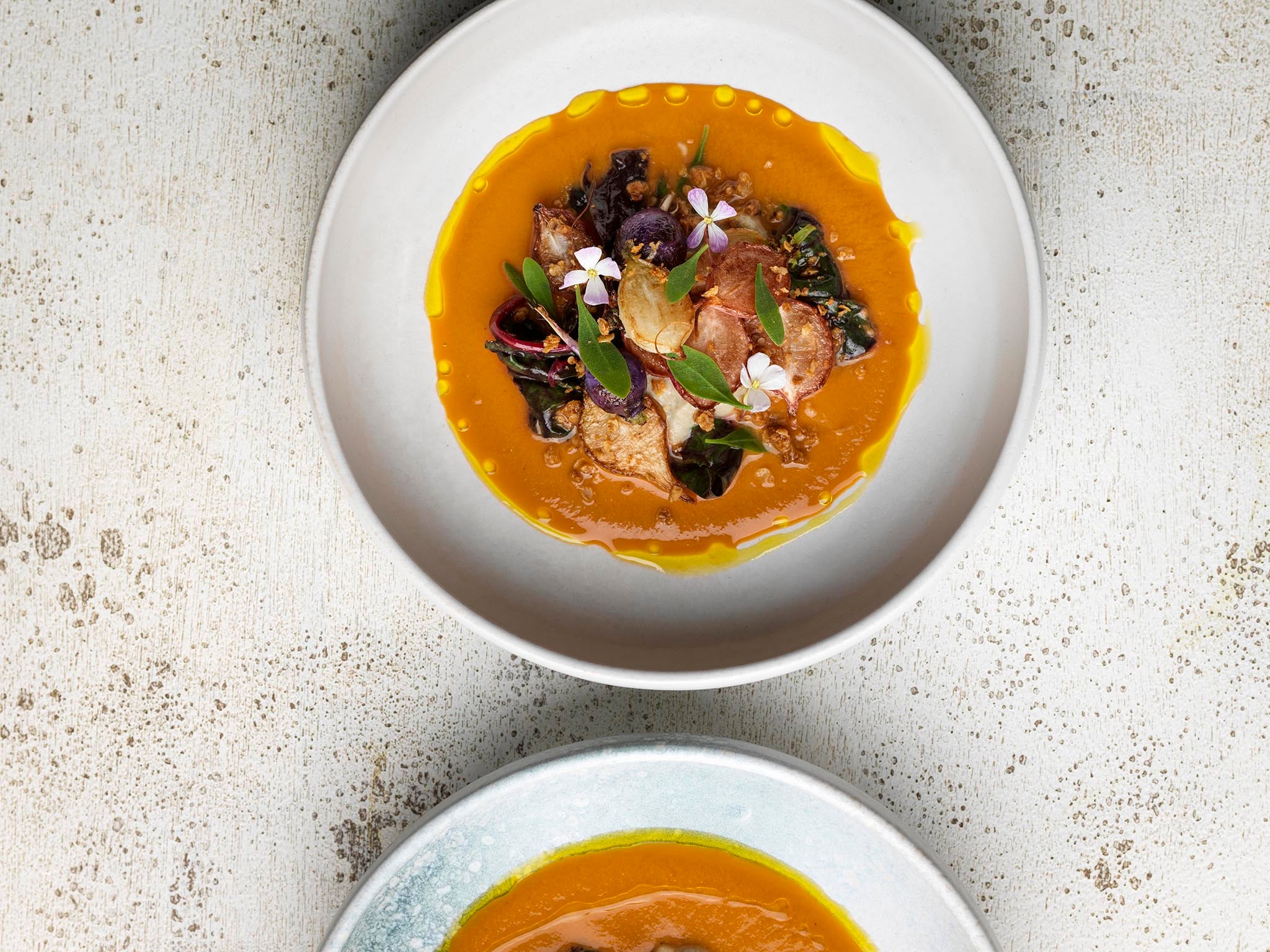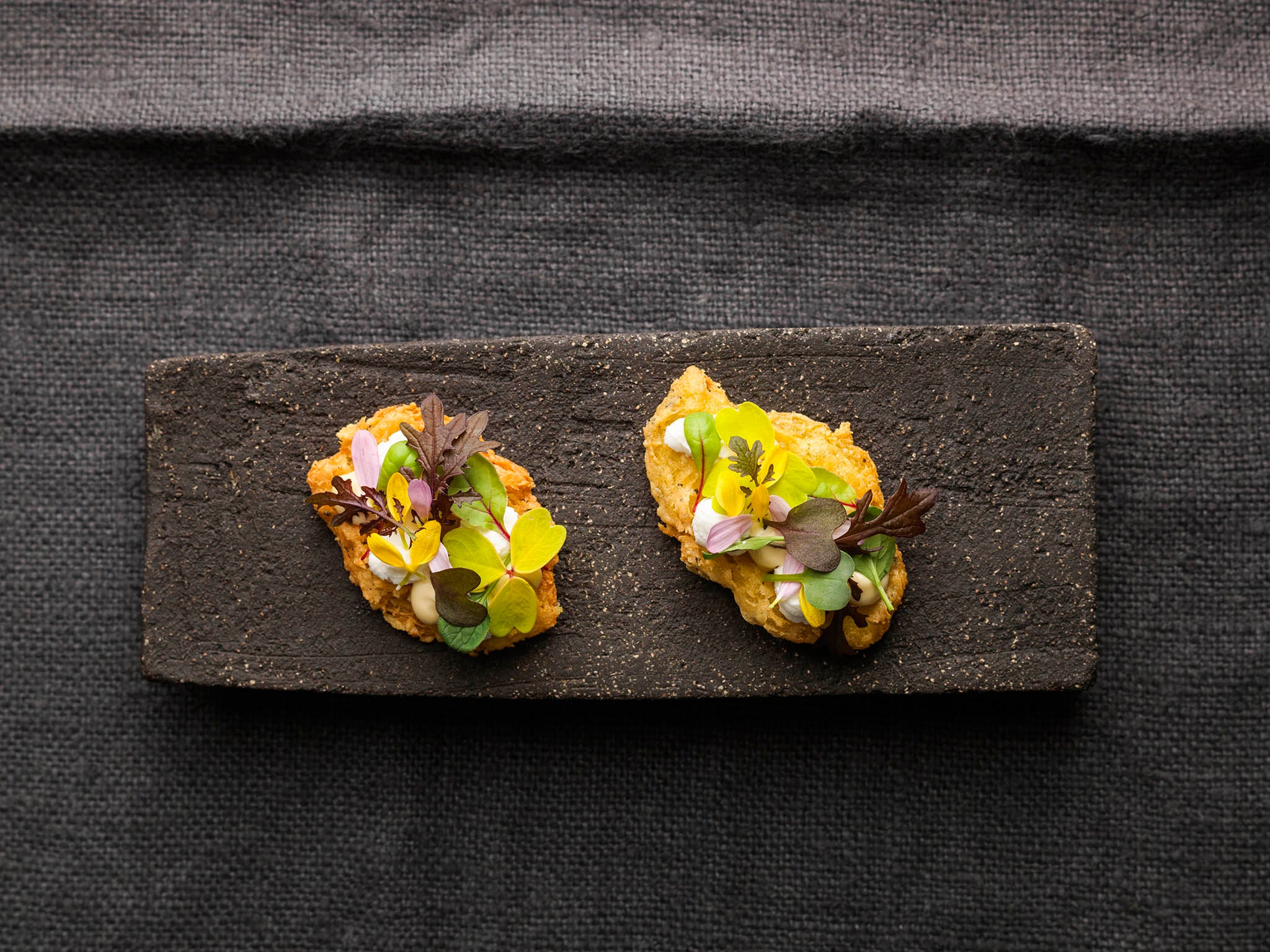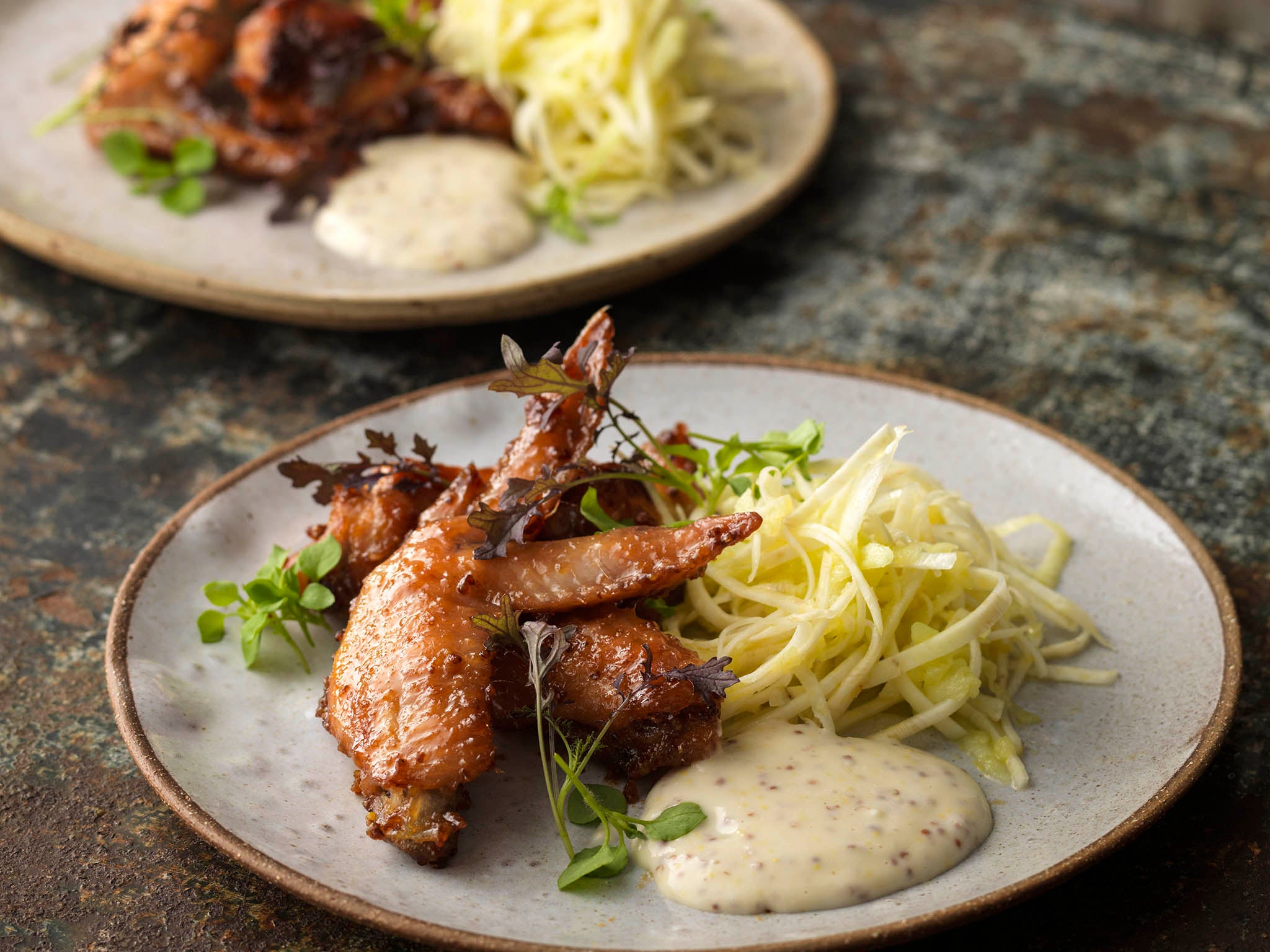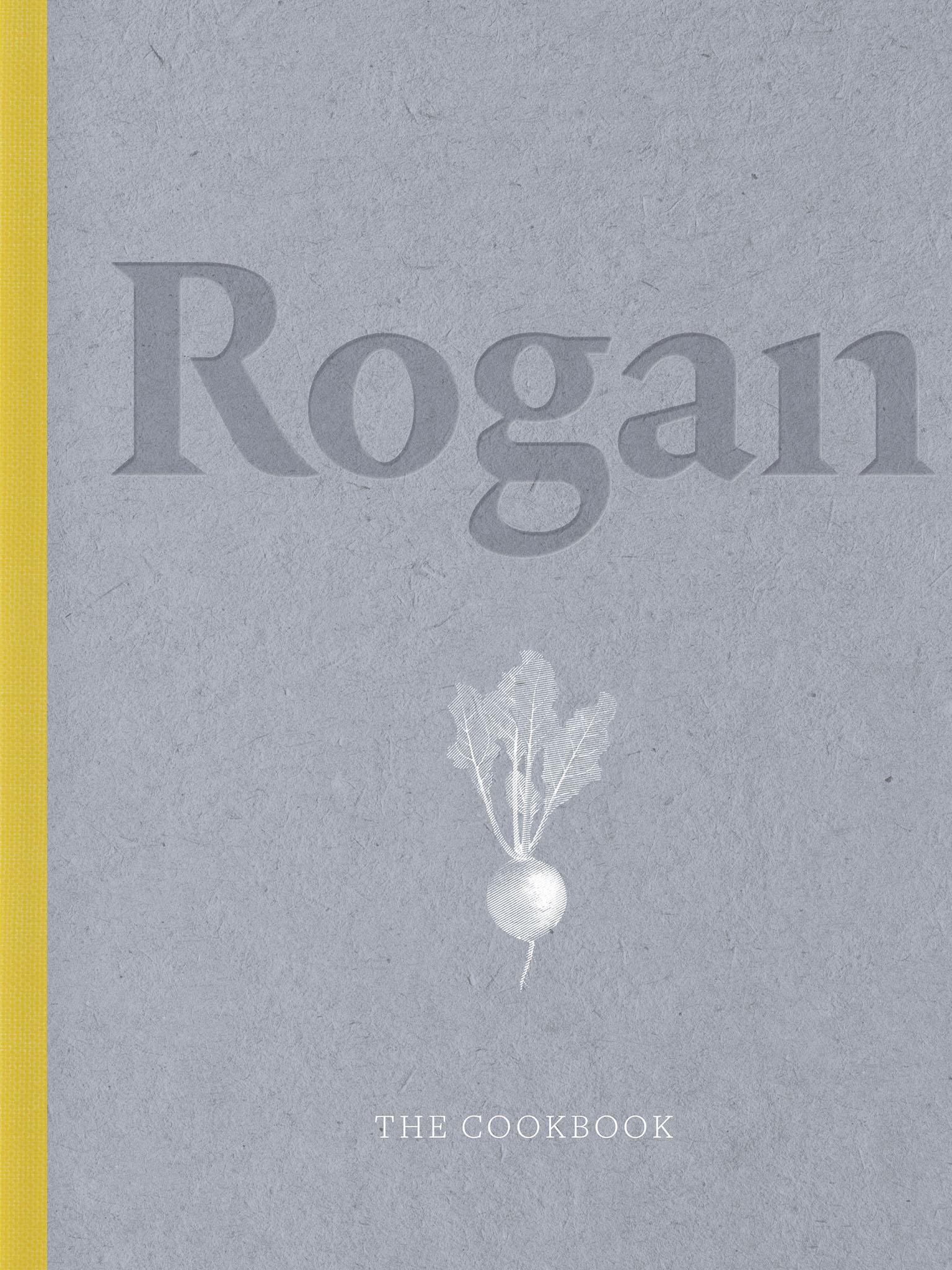Rogan cookbook recipes: From radish stew to chickpea wafer with goat’s curd
In his new book, Simon Rogan shows that farmed and foraged seasonal ingredients can come together to create delicious and sophisticated dishes. Here's a selection of recipes

Radish stew
Serves 4, as a starter
Aubergine purée
1 large aubergine (about 450g)
½ tbsp tahini paste
1 tbsp natural yoghurt
½ tsp roasted chopped garlic
Radish sauce
1 tbsp sunflower oil
1 shallot, sliced
40g button mushrooms, sliced
1½ tsp tomato purée
250g red radishes, thinly sliced
500ml vegetable stock (see recipe at end of main recipe)
Sherry vinegar, for seasoning
5g unsalted butter
Truffle granola
135g honey
35g black truffle oil
35g chilli oil
150g porridge oats
Radishes
12 mixed radishes, such as Cherry Belle, Albena and Viola
2 tbsp rapeseed oil
8 stalks of rhubarb chard (or Swiss chard), stalks removed and cut in half
Salt, for seasoning
Rapeseed oil, for drizzling
Assorted radish flowers and sea purslane, to serve
Preheat the oven to 200°C/180°C Fan/Gas Mark 6.First, make the aubergine purée. Wrap the aubergine in foil and bake it in the oven for 35-40 minutes until completely soft, then halve it lengthways and scoop out the flesh. Put the flesh in a blender with the tahini, yoghurt and garlic and blitz until smooth. Pass through a fine sieve and season with a pinch of salt.
While the aubergine is cooking, make the radish sauce. Warm the oil in a medium, heavy-based saucepan over a medium heat, add the shallot and sweat for 5-6 minutes, or until translucent, stirring regularly. Add the mushrooms and sweat for a further 3 minutes, or until soft and tender. Stir in the tomato purée and cook for 3-4 minutes. Add the radishes and vegetable stock and bring to the boil. Reduce the heat and simmer for 8 minutes. Remove from the heat and blitz with a hand-held blender until smooth, then strain through a fine sieve. Finish the sauce by seasoning with sherry vinegar and salt and whisking in the butter.
Reduce the oven temperature to 160°C/140°C Fan/Gas Mark 2. To make the granola, warm the honey, oils and 1 teaspoon of salt in a small saucepan over a low heat until the honey has melted and the salt dissolved. Mix in the oats. Transfer to a baking tray, spread it out in an even layer and bake for 15 minutes, or until golden. Remove from the oven and leave to cool, then break into small pieces. Leave the oven at the same temperature.
Put the radishes on a baking tray, chopping any larger ones in half, season with a pinch of salt, drizzle over half the oil and roast for 10-12 minutes. Heat the remaining oil in a medium non-stick saucepan and add the rhubarb chard leaves along with a splash of water. Cook gently until the leaves have wilted and season with a little salt.
Warm the radish sauce. Put a spoon of the purée in the centre of four plates and place the roasted radishes on top. Add the chard, purslane leaves and flowers. Spoon the sauce around the outside and sprinkle with truffle granola. Drizzle with rapeseed oil.
Vegetable stock
3 onions, finely chopped
2 celery sticks, finely chopped
2 carrots, finely chopped
1 fennel bulb, finely chopped
1 leek, finely chopped
1 head of garlic, halved
15g chervil
15g tarragon
15g flat-leaf parsley
Put all the vegetables and the garlic halves in a large heavy-based saucepan with 4 litres of water. Bring to the boil over a medium heat, then reduce the heat and simmer for 30 minutes. Take off the heat, add the herbs and leave to cool, then chill and infuse in the fridge overnight. The following day, strain it through a muslin-lined sieve. Keep the stock covered in the fridge and use within 3-4 days, or freeze and use within 3 months.

Chickpea wafer with goat’s curd
Serves 6, as a starter
Chickpea wafer
80g gram flour
1 tsp salt
1 tbsp finely chopped rosemary needles
Vegetable oil, for deep-frying
Garlic emulsion
1 head of garlic
2 egg yolks
1 tbsp made English mustard
1 tsp sherry vinegar
½ tsp Worcestershire sauce
Juice of ½ lemon
A pinch of salt
125ml sunflower oil
50g fresh goat’s curd
Chive flowers, turnip tops, radish shoots, viola flowers, primrose flowers, nasturtium flowers, to serve
To make the chickpea wafer, put the flour, salt and rosemary in a medium heavy-based saucepan over a medium heat, add 150ml water and mix well. Cook for 4-5 minutes, stirring the mixture constantly, until it becomes very, very thick.
When thickened, remove from the heat, spread teaspoons of the wafer mix on to a sheet of baking parchment to a thickness of about 5mm and let it cool to room temperature, cutting out 4cm oval shapes. Peel the wafers off the parchment when cool and deep-fry them in batches in a pan of oil heated to 180°C for 3-5 minutes, or until lightly golden, turning them regularly so they cook evenly. Remove with a slotted spoon and drain on kitchen paper. Leave to cool until ready to serve.
Preheat the oven to 200°C/180°C Fan/Gas Mark 6. Wrap the whole head of garlic in foil and bake it for about 40 minutes, or until the garlic is very soft to the touch. When cooked, remove the soft flesh from the garlic skins and add it to a blender along with the rest of the ingredients (except the oil). Blitz to combine, then gradually add the oil until the emulsion has a mayonnaise consistency. Spread the goat’s curd on to the crispy wafers, followed by the garlic emulsion.
Decorate with the herbs and flowers.

Celeriac and mustard-glazed chicken wings with celeriac and apple salad
Serves 4, as a starter
Celeriac and mustard-glazed chicken wings
1 medium celeriac (about 450g)
45g wholegrain mustard
100g honey
20g unsalted butter
12 chicken wings
Wholegrain mustard emulsion
1 soft-boiled egg (cooked for 4 minutes)
25g wholegrain mustard
5ml white wine vinegar
1½ tsp honey
A pinch of salt
150ml sunflower oil
Celeriac and apple salad
1 medium celeriac (about 450g)
2 Granny Smith apples
20ml rapeseed oil
Juice of 1 lemon
Salt, for seasoning
Chickweed and golden streak mustard leaves, to serve
Preheat the oven to 200°C/180°C Fan/Gas Mark 6. For the glazed chicken wings, peel and juice the celeriac in a juicer. Put the juice in a small saucepan over a medium heat with a pinch of salt and reduce by half.
Remove from the heat and add the mustard, honey and butter. Mix well. Toss the wings in the glaze and put in a single layer on a baking tray. Bake for 40 minutes until golden and sticky. While the chicken is cooking, put all the ingredients for the emulsion, except the oil, in the blender along with 1½ teaspoons of water. Blend together slowly.

Gradually add the oil until the emulsion has a mayonnaise consistency. To make the salad, peel the celeriac then shave it using a peeler and cut the shavings into strips. Put the strips in a bowl. Peel the apples and grate them into the celeriac. Dress with the oil, lemon juice and a pinch of salt.
Divide the warm chicken wings among plates and add the salad, emulsion and leaves.
'Rogan: The Cookbook' by Simon Rogan, with photography by Cristian Barnett (HarperCollins, £30)
Join our commenting forum
Join thought-provoking conversations, follow other Independent readers and see their replies
Comments